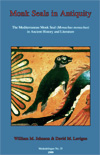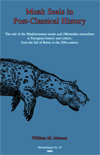

MONK SEALS IN ANTIQUITY
The Mediterranean monk seal (Monachus monachus)
in ancient history and literature
The role of the Mediterranean monk seal (Monachus monachus) in the history and culture of ancient Greece and Rome is poorly documented in contemporary literature and generally misunderstood by many modern scholars. A comprehensive search was initiated therefore to locate all surviving references to the species in the classical literature of the Mediterranean region. The search yielded over 200 references authored by some 60 writers from the Greek, Roman and Byzantine periods. Examination of these texts, together with information derived from numerous secondary sources, provides new insights into the monk seal’s distribution and abundance in antiquity. It also reveals ancient human attitudes toward the monk seal that resulted in its exploitation for fur, oil and meat, its use in medicines and entertainment, and its role in mythology and superstition. The accumulated evidence now suggests that many of the large monk seal herds that existed in early antiquity were either dramatically reduced or extirpated by intensive exploitation during the Roman era. Throughout much of its historical range, human persecution and progressive habitat deterioration also appear largely responsible for changing a naturally gregarious beach dweller into a less social and reclusive inhabiter of caves.

MONK SEALS IN POST-CLASSICAL HISTORY
The role of the Mediterranean monk seal (Monachus monachus) in European history and culture,
from the fall of Rome to the 20th century.
The role of the Mediterranean monk seal Monachus monachus in the history, culture and economy of the Mediterranean region has long remained obscure and subject to error and contradiction. In order to extend historical knowledge of the species beyond the time-frame covered in our companion publication, Monk Seals in Antiquity, a review of the available literature was undertaken covering the period from the fall of Rome to the 20th century. This research indicates that the monk seal in the Mediterranean continued to be exploited for its fur, oil, meat and perceived medicinal properties well into the Dark Ages and the Renaissance, albeit on a much-reduced scale than the exploitation witnessed during the Roman era. The species also continued to be a target of Mediterranean fishers, angered over reduced catches and damaged nets. Elsewhere, large, newly-discovered colonies in the eastern Atlantic off the coast of Africa became a lucrative if short-lived industry for French, Portuguese and Spanish explorers. In the Mediterranean, sustained persecution of surviving groups, coupled with increasing human disturbance and deterioration of habitat, appears to have acted selectively against colony formation, leading to an inexorable decline and fragmentation of the population. Although described as ‘rare’ by science in 1779, the species continued to be a target for collectors from zoos and museums until the early 20th century, when extinctions along broad stretches of coastline first became apparent.